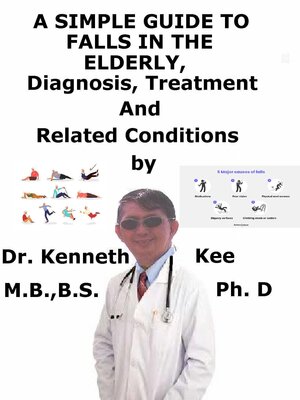A Simple Guide to Falls in the Elderly, Diagnosis, Treatment and Related Conditions
ebook
By Kenneth Kee

Sign up to save your library
With an OverDrive account, you can save your favorite libraries for at-a-glance information about availability. Find out more about OverDrive accounts.
Find this title in Libby, the library reading app by OverDrive.



Search for a digital library with this title
Title found at these libraries:
| Library Name | Distance |
|---|---|
| Loading... |
Fifty years later as a family doctor I have found that many health conditions such as falls, poor balance, poor eyesight, urinary incontinence, muscle weakness and chronic illnesses happen very frequently in the elderly.
I have taken many of the contents from my older series of simple guide to different medical conditions to concentrate on these disorders that are happening in the elderly patients.
Old people have acquired much wisdom,
Their bodies however do not blossom,
The body muscles and eyes are weak,
They fall on paths that they can not clearly see.
In the past 6 months I have seen about at least 10 cases of falls in the elderly including my family, cousins and aged patients.
Fracture of hip –the most common fracture caused by falls in the elderly
Fracture of spine
Fracture of knee
Fracture of shoulder-the third most frequent fracture caused by falls in the elderly
Fracture and dislocation of ankle
Fracture of wrist
Fracture of facial bone
Knee hematoma
Bruises from falls in elderly are common appearances on the skin of injured patients.
There were bruises on the body in all the patients who fell and fractured their shoulder and on the face for patients who fell and hit their face.
Many patients also had bruises on their knees, elbows and hands when they fell forwards on the ground or hard object.
Subdural hematoma in the brain may occur in rare cases when the elderly patient fell and hit his or her head on the ground or hard object.
Falls happen often in the elderly person over the age of 65.
Falls in the elderly person are the leading cause of injury linked deaths in this age group.
20-30% of falls result in moderate to severe injuries (fractures, head trauma).
Falls in the Elderly account for 40% of nursing home admissions
Risk Factors
Risk factors include:
1. Previous history of falling
2. Use of assistive devices like walkers or canes
3. Poorly lit environments
4. Cluttered environments
5. Health conditions that cause muscle weakness
6. History of vertigo
7. Issues with balance or walking
8. Trouble seeing or hearing
9. Decrease in cognitive ability
10. Diabetes, heart disease
11. Osteoporosis
12. Medication
TABLE OF CONTENT
Introduction
Chapter 1 Falls in the Elderly
Chapter 2 Cause
Chapter 3 Symptoms
Chapter 4 Diagnosis
Chapter 5 Treatment
Chapter 6 Prognosis
Chapter 7 Proximal Humerus Fracture
Chapter 8 Fractures
Epilogue







